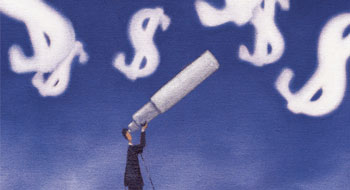

Celebrations at the demise of the recession may be a bit premature, as significant risks remain. Not least of these is another round of financial crises, which will threaten the solvency of even the most austere governments.
“The banking and credit bubble have not yet played out. My prognostications are somewhat gloomy,” said Simon Hill, Senior Consultant with Buck Consulting, during a recent market outlook webinar by the consulting firm.
“Are we looking at a second wave of financial crisis? I think we may be,” he said. “The risk is not only that governments need to be refinanced, but what they are standing behind in the financial system.”
Ireland, for example, was first to announce austerity, yet the premiums on credit default swaps for its debt have risen steadily. But the Irish government has guaranteed billions of euros in debt sitting it’s the private banking system, the equivalent of 95% of Irish GDP.
“Although many (banks) are out of the emergency ward, they are not out of the hospital,” he continued.
In terms of sentiment, there’s a tug of war between those who see inflation—which would be good for equities, and those anticipating deflation—which would be bad for equities.
Both the Great Depression and the recession of the early 1970s were based on financial crises, and both followed the double dip pattern. But despite his forecast for another wave of financial crisis, Hill doesn’t expect a double-dip this time around.
In 2012, he expects the U.K. and Europe will follow through on their austerity measures, which will result in slower growth, but that the U.S. will likely see a return to consumer and government spending.
In the U.K., there have been far fewer liquidations of companies than the last major recession. What has recovered in this recession is labour productivity, while unemployment has remained higher.
Pessimists are looking at the latest recession and worry that it signals an external shock, which resulted in a permanent setback for economic growth.
Another popular interpretation is that the global economy has undergone an endogenous shift that will result in lower growth capacity for the long-term. “I think the problem is more severe than that. I see stagflation,” says Hill. “I think for the foreseeable future we’ll see reduced growth and a risk of higher inflation. Endemic structural inflation is already starting to appear,” despite a lack of growth.
While many central bank critics point to quantitative easing as the cause of inflation, Hill points out that these measures have not fully reversed the contraction in money supply resulting from the evaporation of credit.
What is driving inflation is demand for commodities, driven by growth in the emerging markets. The first to rise were energy and industrial metals, but these are now being followed by agricultural commodities and livestock prices.
Related Links
Bonds: not to be forgotten – By Greg Rodger and Dan Hallett
Canadian equity bull has room to run – By Vikram Barhat
Economists predict growth in major markets – By Suzanne Sharma
Pensions funding status hits a wall – By April Scott-Clarke
